lock BMW 3 SERIES 2001 E46 Drive Away Protection Syst
[x] Cancel search | Manufacturer: BMW, Model Year: 2001, Model line: 3 SERIES, Model: BMW 3 SERIES 2001 E46Pages: 30, PDF Size: 0.7 MB
Page 3 of 30
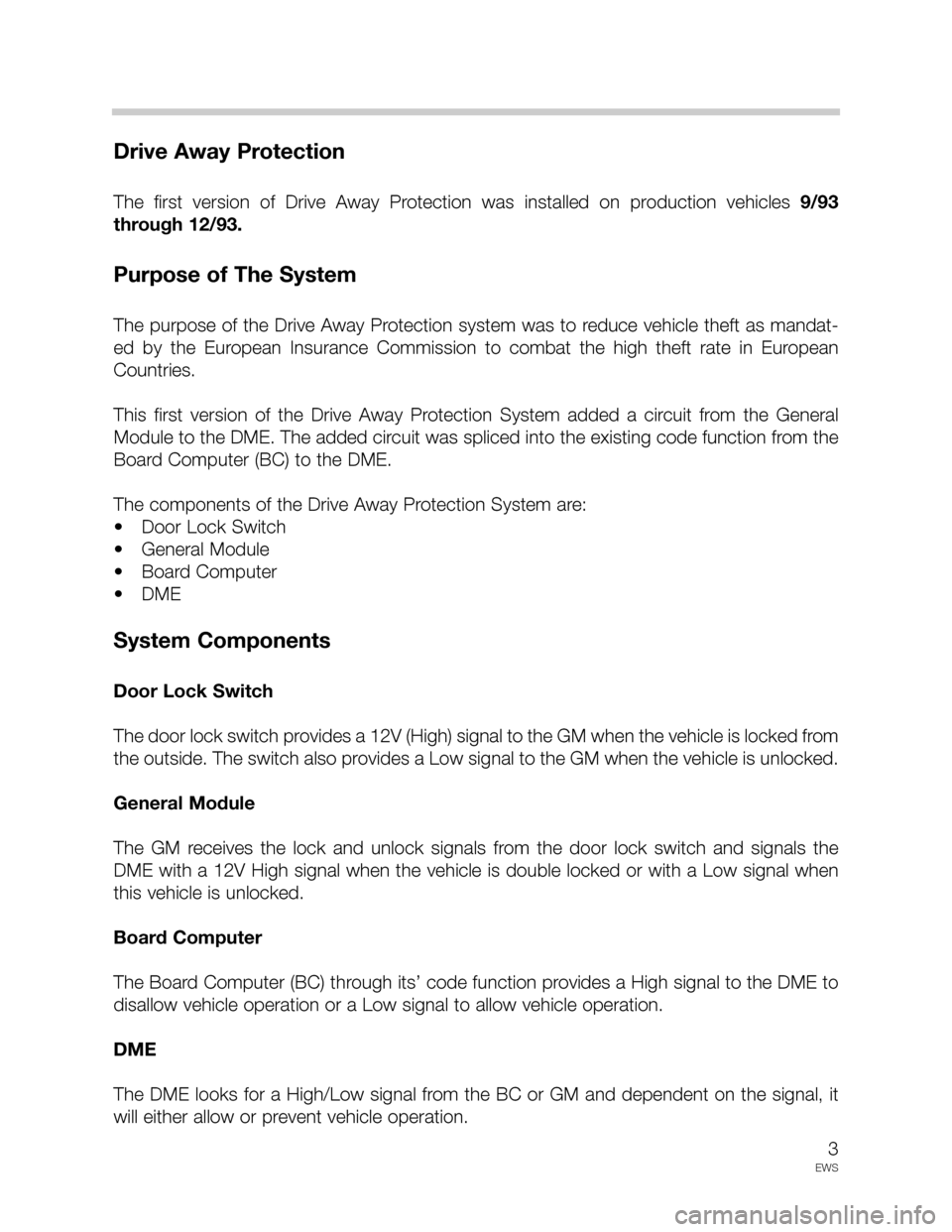
3
EWS
Drive Away Protection
The first version of Drive Away Protection was installed on production vehicles 9/93
through 12/93.
Purpose of The System
The purpose of the Drive Away Protection system was to reduce vehicle theft as mandat-
ed by the European Insurance Commission to combat the high theft rate in European
Countries.
This first version of the Drive Away Protection System added a circuit from the General
Module to the DME. The added circuit was spliced into the existing code function from the
Board Computer (BC) to the DME.
The components of the Drive Away Protection System are:
• Door Lock Switch
• General Module
• Board Computer
• DME
System Components
Door Lock Switch
The door lock switch provides a 12V (High) signal to the GM when the vehicle is locked from
the outside. The switch also provides a Low signal to the GM when the vehicle is unlocked.
General Module
The GM receives the lock and unlock signals from the door lock switch and signals the
DME with a 12V High signal when the vehicle is double locked or with a Low signal when
this vehicle is unlocked.
Board Computer
The Board Computer (BC) through its’ code function provides a High signal to the DME to
disallow vehicle operation or a Low signal to allow vehicle operation.
DME
The DME looks for a High/Low signal from the BC or GM and dependent on the signal, it
will either allow or prevent vehicle operation.
Page 4 of 30
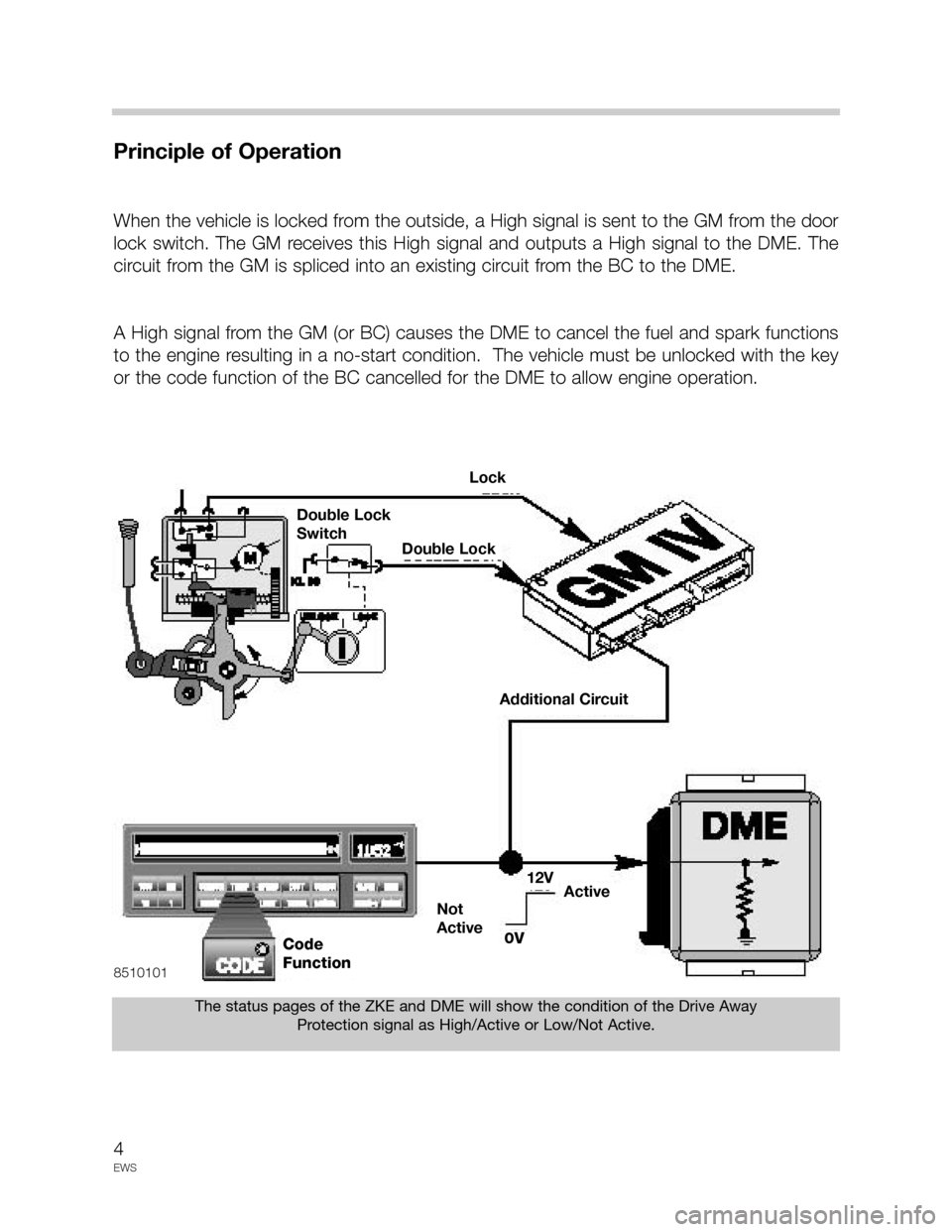
4
EWS
Principle of Operation
When the vehicle is locked from the outside, a High signal is sent to the GM from the door
lock switch. The GM receives this High signal and outputs a High signal to the DME. The
circuit from the GM is spliced into an existing circuit from the BC to the DME.
A High signal from the GM (or BC) causes the DME to cancel the fuel and spark functions
to the engine resulting in a no-start condition. The vehicle must be unlocked with the key
or the code function of the BC cancelled for the DME to allow engine operation.
The status pages of the ZKE and DME will show the condition of the Drive Away
Protection signal as High/Active or Low/Not Active.
8510101
Lock
Double Lock
Double Lock
Switch
Additional Circuit
12VActive
Not
Active
0VCode
Function
Page 5 of 30
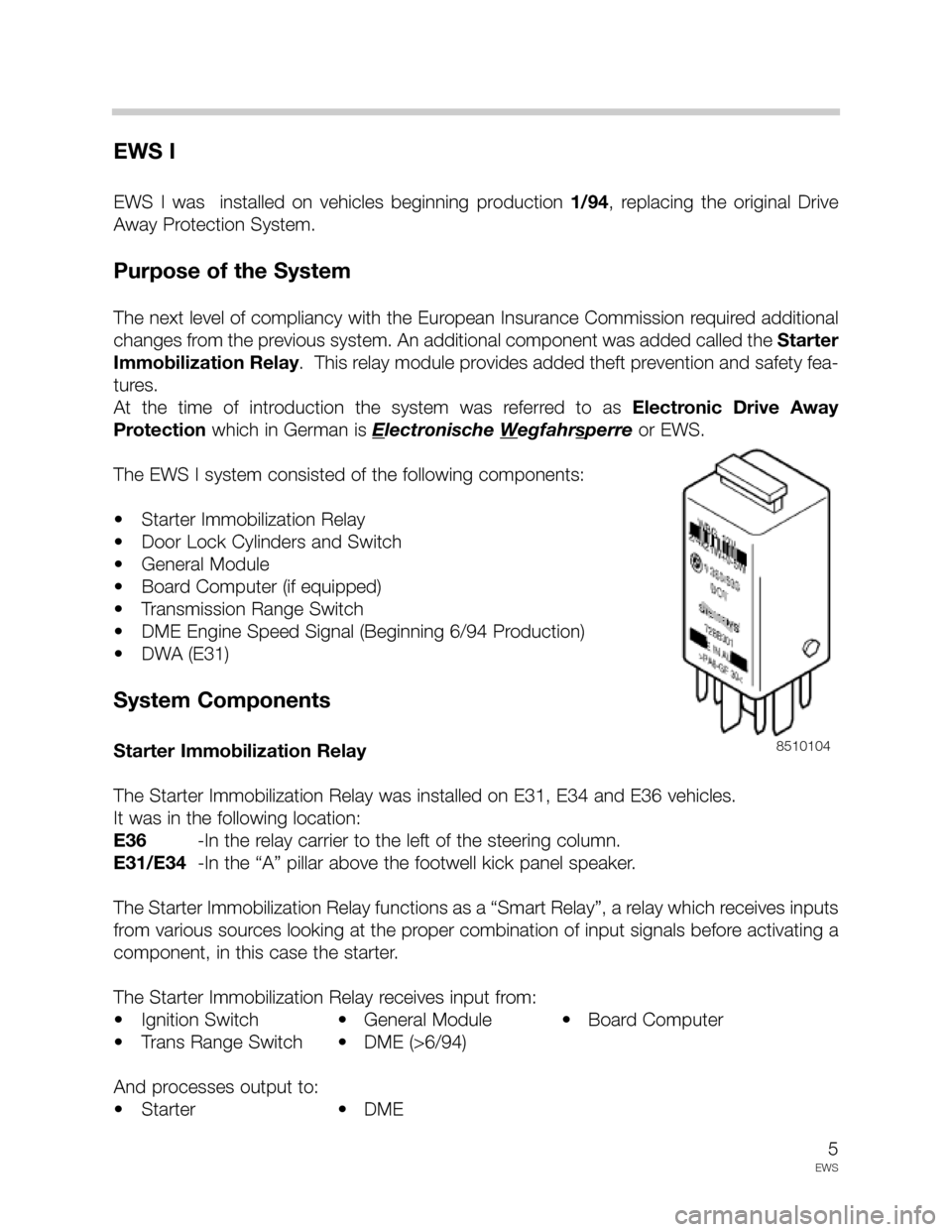
5
EWS
EWS I
EWS I was installed on vehicles beginning production 1/94, replacing the original Drive
Away Protection System.
Purpose of the System
The next level of compliancy with the European Insurance Commission required additional
changes from the previous system. An additional component was added called the Starter
Immobilization Relay. This relay module provides added theft prevention and safety fea-
tures.
At the time of introduction the system was referred to as Electronic Drive Away
Protectionwhich in German is E
lectronische Wegfahrsperreor EWS.
The EWS I system consisted of the following components:
• Starter Immobilization Relay
• Door Lock Cylinders and Switch
• General Module
• Board Computer (if equipped)
• Transmission Range Switch
• DME Engine Speed Signal (Beginning 6/94 Production)
• DWA (E31)
System Components
Starter Immobilization Relay
The Starter Immobilization Relay was installed on E31, E34 and E36 vehicles.
It was in the following location:
E36 -In the relay carrier to the left of the steering column.
E31/E34-In the “A” pillar above the footwell kick panel speaker.
The Starter Immobilization Relay functions as a “Smart Relay”, a relay which receives inputs
from various sources looking at the proper combination of input signals before activating a
component, in this case the starter.
The Starter Immobilization Relay receives input from:
• Ignition Switch • General Module • Board Computer
• Trans Range Switch • DME (>6/94)
And processes output to:
• Starter • DME8510104
Page 6 of 30
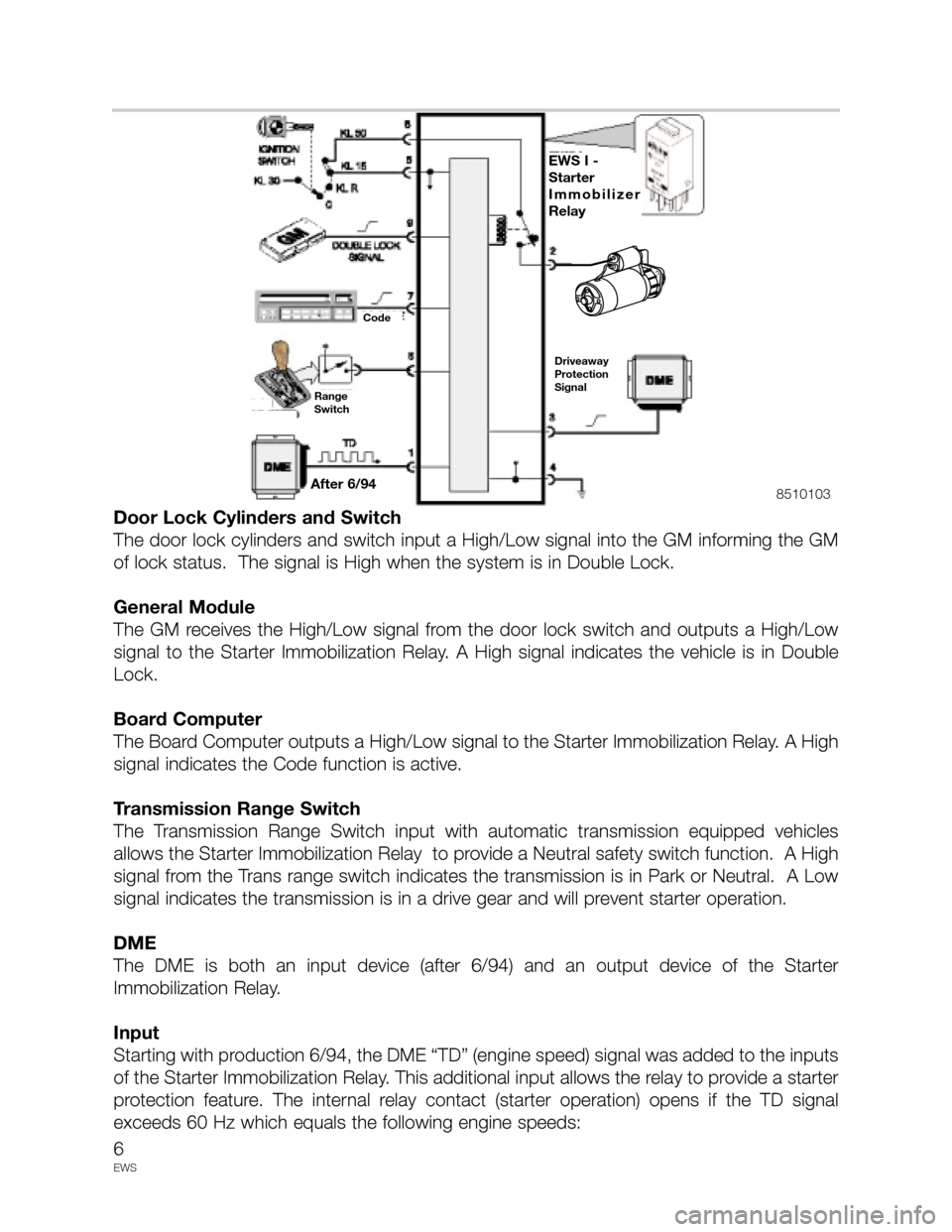
6
EWS
Door Lock Cylinders and Switch
The door lock cylinders and switch input a High/Low signal into the GM informing the GM
of lock status. The signal is High when the system is in Double Lock.
General Module
The GM receives the High/Low signal from the door lock switch and outputs a High/Low
signal to the Starter Immobilization Relay. A High signal indicates the vehicle is in Double
Lock.
Board Computer
The Board Computer outputs a High/Low signal to the Starter Immobilization Relay. A High
signal indicates the Code function is active.
Transmission Range Switch
The Transmission Range Switch input with automatic transmission equipped vehicles
allows the Starter Immobilization Relay to provide a Neutral safety switch function. A High
signal from the Trans range switch indicates the transmission is in Park or Neutral. A Low
signal indicates the transmission is in a drive gear and will prevent starter operation.
DME
The DME is both an input device (after 6/94) and an output device of the Starter
Immobilization Relay.
Input
Starting with production 6/94, the DME “TD” (engine speed) signal was added to the inputs
of the Starter Immobilization Relay. This additional input allows the relay to provide a starter
protection feature. The internal relay contact (starter operation) opens if the TD signal
exceeds 60 Hz which equals the following engine speeds:
8510103
EWS I -
Starter
Immobilizer
Relay
After 6/94
Driveaway
Protection
Signal
Range
Switch
Code
Page 7 of 30
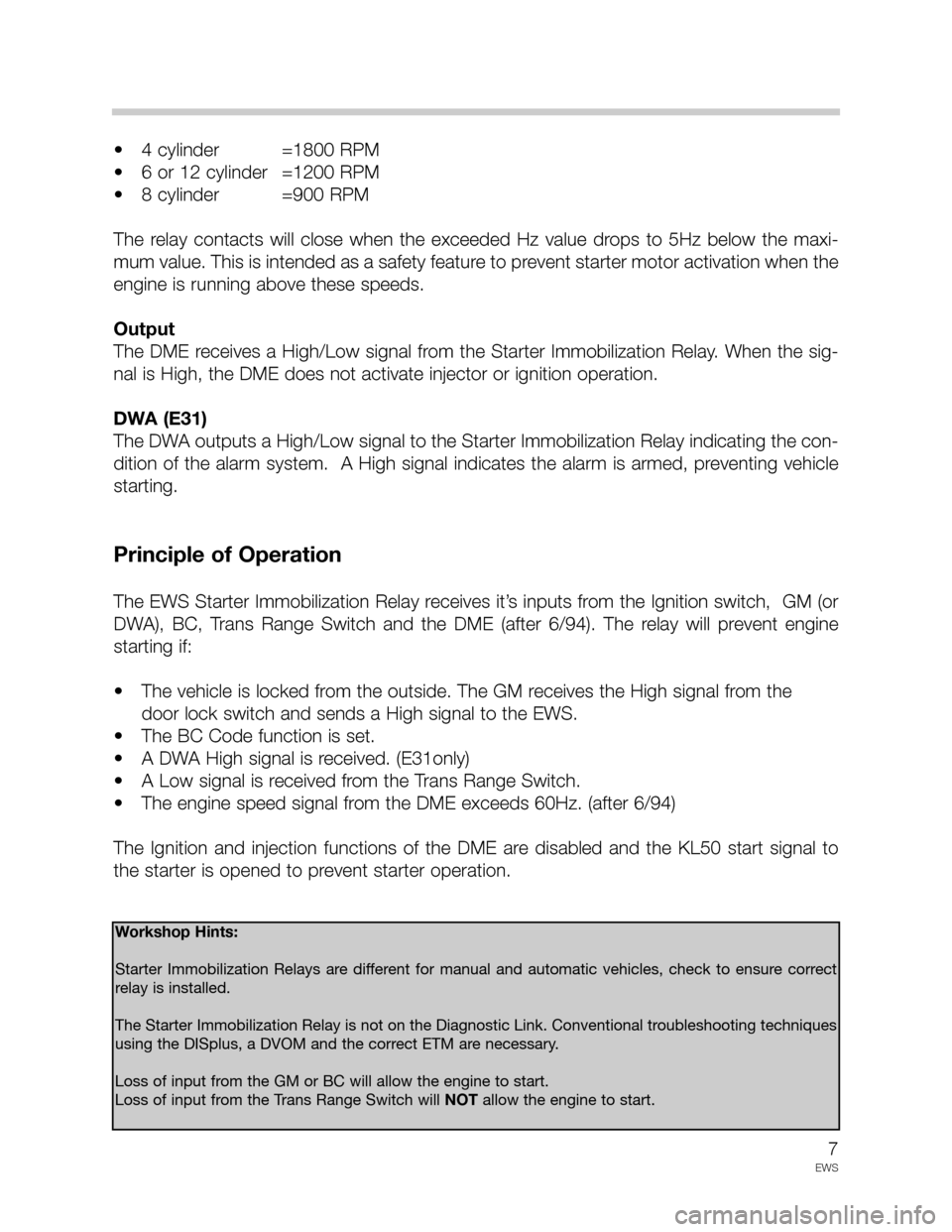
7
EWS
• 4 cylinder =1800 RPM
• 6 or 12 cylinder =1200 RPM
• 8 cylinder =900 RPM
The relay contacts will close when the exceeded Hz value drops to 5Hz below the maxi-
mum value. This is intended as a safety feature to prevent starter motor activation when the
engine is running above these speeds.
Output
The DME receives a High/Low signal from the Starter Immobilization Relay. When the sig-
nal is High, the DME does not activate injector or ignition operation.
DWA (E31)
The DWA outputs a High/Low signal to the Starter Immobilization Relay indicating the con-
dition of the alarm system. A High signal indicates the alarm is armed, preventing vehicle
starting.
Principle of Operation
The EWS Starter Immobilization Relay receives it’s inputs from the Ignition switch, GM (or
DWA), BC, Trans Range Switch and the DME (after 6/94). The relay will prevent engine
starting if:
• The vehicle is locked from the outside. The GM receives the High signal from the
door lock switch and sends a High signal to the EWS.
• The BC Code function is set.
• A DWA High signal is received. (E31only)
• A Low signal is received from the Trans Range Switch.
• The engine speed signal from the DME exceeds 60Hz. (after 6/94)
The Ignition and injection functions of the DME are disabled and the KL50 start signal to
the starter is opened to prevent starter operation.
Workshop Hints:
Starter Immobilization Relays are different for manual and automatic vehicles, check to ensure correct
relay is installed.
The Starter Immobilization Relay is not on the Diagnostic Link. Conventional troubleshooting techniques
using the DISplus, a DVOM and the correct ETM are necessary.
Loss of input from the GM or BC will allow the engine to start.
Loss of input from the Trans Range Switch will NOTallow the engine to start.
Page 10 of 30
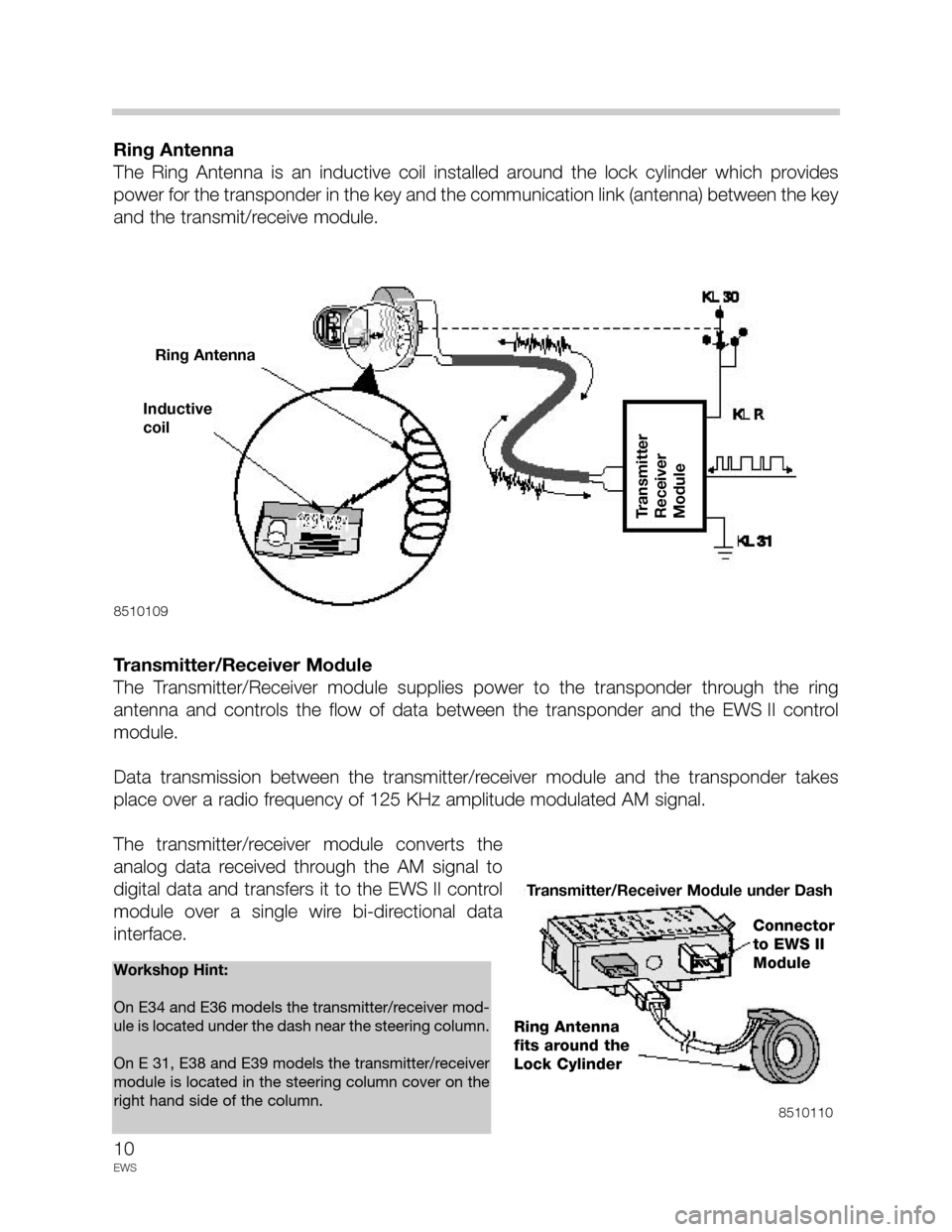
10
EWS
Ring Antenna
The Ring Antenna is an inductive coil installed around the lock cylinder which provides
power for the transponder in the key and the communication link (antenna) between the key
and the transmit/receive module.
Transmitter/Receiver Module
The Transmitter/Receiver module supplies power to the transponder through the ring
antenna and controls the flow of data between the transponder and the EWS II control
module.
Data transmission between the transmitter/receiver module and the transponder takes
place over a radio frequency of 125 KHz amplitude modulated AM signal.
The transmitter/receiver module converts the
analog data received through the AM signal to
digital data and transfers it to the EWS II control
module over a single wire bi-directional data
interface.
8510109
8510110
Workshop Hint:
On E34 and E36 models the transmitter/receiver mod-
ule is located under the dash near the steering column.
On E 31, E38 and E39 models the transmitter/receiver
module is located in the steering column cover on the
right hand side of the column.
Inductive
coil
Ring Antenna
Transmitter
Receiver
Module
Transmitter/Receiver Module under Dash
Connector
to EWS II
Module
Ring Antenna
fits around the
Lock Cylinder
Page 11 of 30
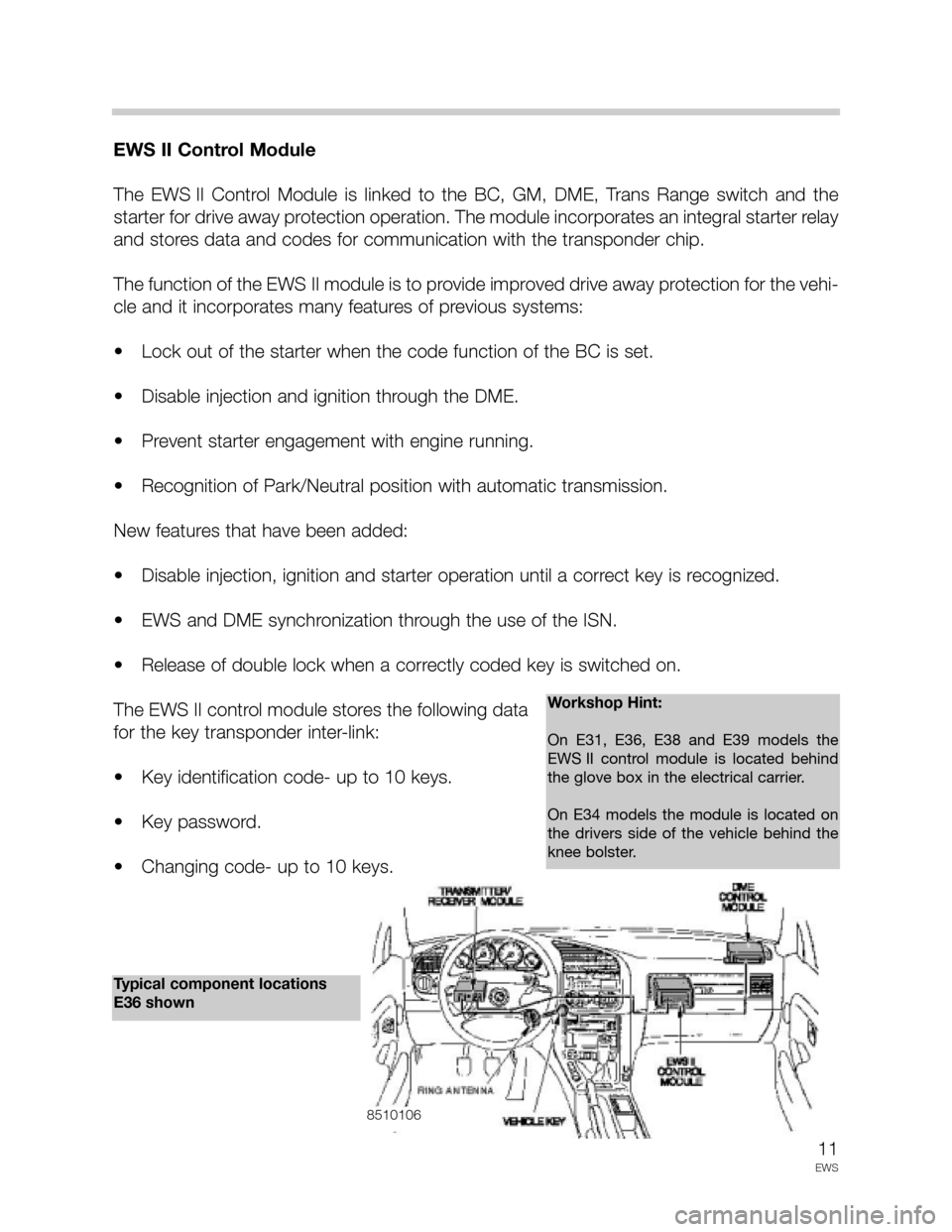
11
EWS
EWS II Control Module
The EWS II Control Module is linked to the BC, GM, DME, Trans Range switch and the
starter for drive away protection operation. The module incorporates an integral starter relay
and stores data and codes for communication with the transponder chip.
The function of the EWS II module is to provide improved drive away protection for the vehi-
cle and it incorporates many features of previous systems:
• Lock out of the starter when the code function of the BC is set.
• Disable injection and ignition through the DME.
• Prevent starter engagement with engine running.
• Recognition of Park/Neutral position with automatic transmission.
New features that have been added:
• Disable injection, ignition and starter operation until a correct key is recognized.
• EWS and DME synchronization through the use of the ISN.
• Release of double lock when a correctly coded key is switched on.
The EWS II control module stores the following data
for the key transponder inter-link:
• Key identification code- up to 10 keys.
• Key password.
• Changing code- up to 10 keys.
Workshop Hint:
On E31, E36, E38 and E39 models the
EWS II control module is located behind
the glove box in the electrical carrier.
On E34 models the module is located on
the drivers side of the vehicle behind the
knee bolster.
8510106
Typical component locations
E36 shown
Page 13 of 30
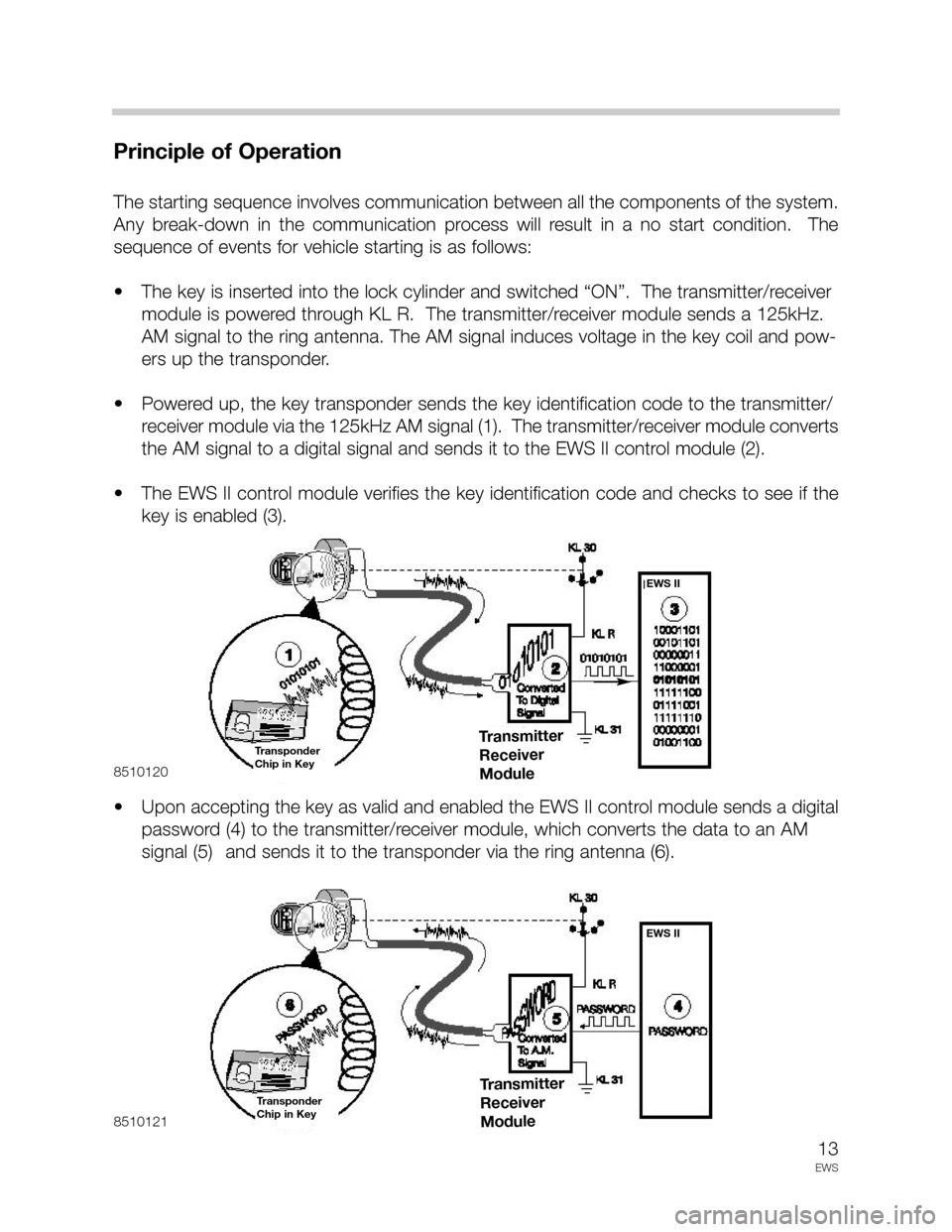
13
EWS
Principle of Operation
The starting sequence involves communication between all the components of the system.
Any break-down in the communication process will result in a no start condition. The
sequence of events for vehicle starting is as follows:
• The key is inserted into the lock cylinder and switched “ON”. The transmitter/receiver
module is powered through KL R. The transmitter/receiver module sends a 125kHz.
AM signal to the ring antenna. The AM signal induces voltage in the key coil and pow-
ers up the transponder.
• Powered up, the key transponder sends the key identification code to the transmitter/
receiver module via the 125kHz AM signal (1). The transmitter/receiver module converts
the AM signal to a digital signal and sends it to the EWS II control module (2).
• The EWS II control module verifies the key identification code and checks to see if the
key is enabled (3).
• Upon accepting the key as valid and enabled the EWS II control module sends a digital
password (4) to the transmitter/receiver module, which converts the data to an AM
signal (5) and sends it to the transponder via the ring antenna (6).
8510120
8510121
Transmitter
Receiver
Module
Transmitter
Receiver
Module
Transponder
Chip in Key
Transponder
Chip in Key
EWS II
EWS II
Page 14 of 30
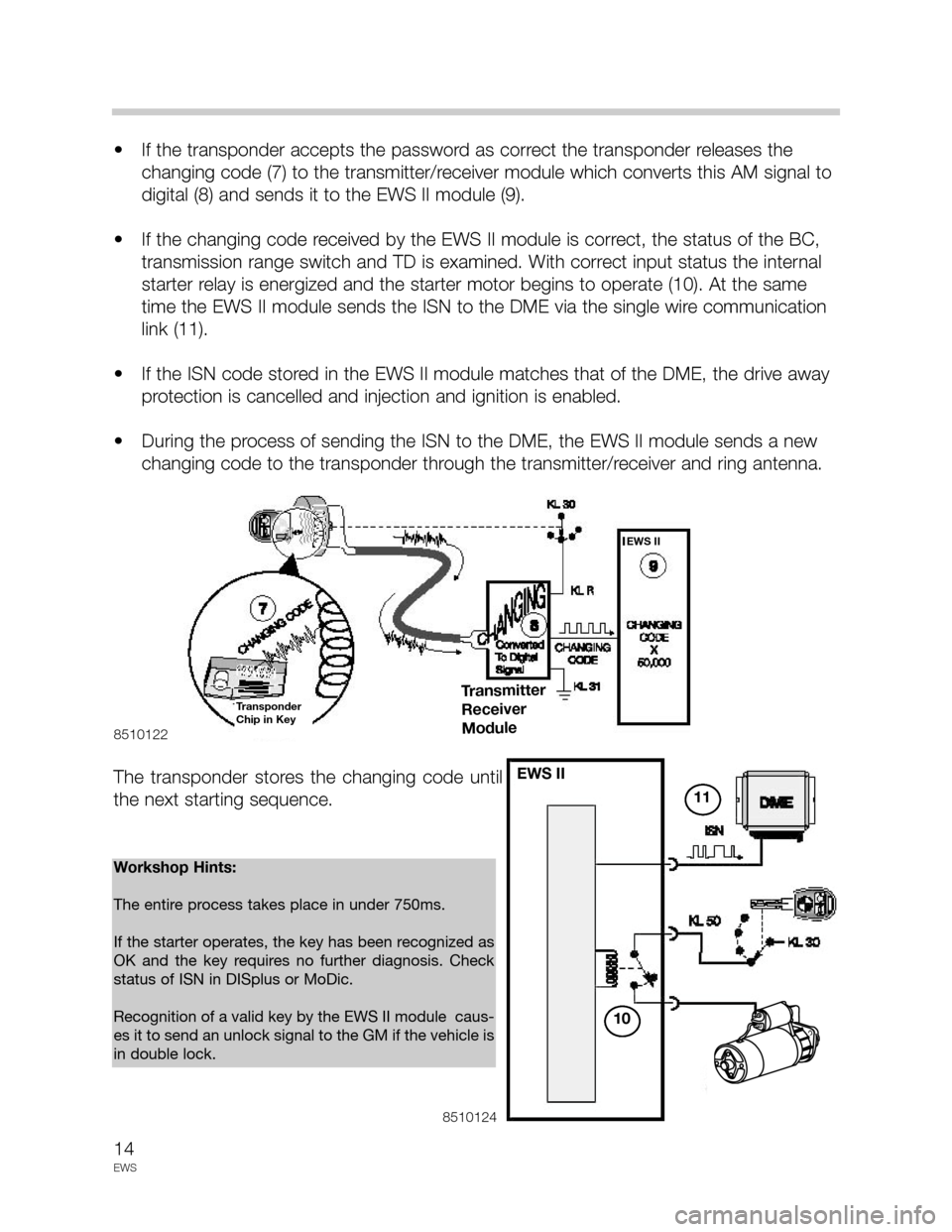
14
EWS
• If the transponder accepts the password as correct the transponder releases the
changing code (7) to the transmitter/receiver module which converts this AM signal to
digital (8) and sends it to the EWS II module (9).
• If the changing code received by the EWS II module is correct, the status of the BC,
transmission range switch and TD is examined. With correct input status the internal
starter relay is energized and the starter motor begins to operate (10). At the same
time the EWS II module sends the ISN to the DME via the single wire communication
link (11).
• If the ISN code stored in the EWS II module matches that of the DME, the drive away
protection is cancelled and injection and ignition is enabled.
• During the process of sending the ISN to the DME, the EWS II module sends a new
changing code to the transponder through the transmitter/receiver and ring antenna.
The transponder stores the changing code until
the next starting sequence.
8510122
8510124
10
11
Workshop Hints:
The entire process takes place in under 750ms.
If the starter operates, the key has been recognized as
OK and the key requires no further diagnosis. Check
status of ISN in DISplus or MoDic.
Recognition of a valid key by the EWS II module caus-
es it to send an unlock signal to the GM if the vehicle is
in double lock.
Transponder
Chip in KeyTransmitter
Receiver
Module
EWS II
EWS II
Page 15 of 30
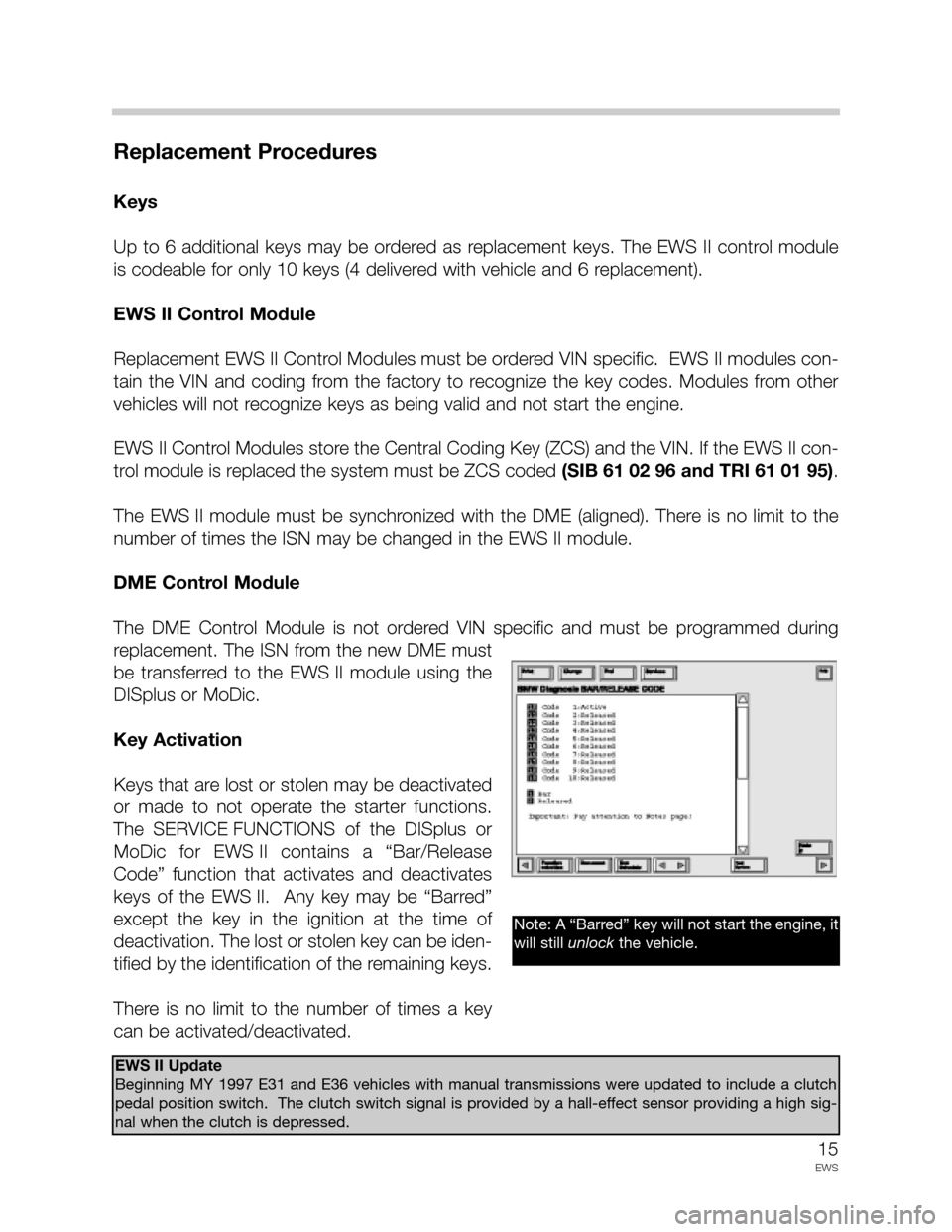
15
EWS
Replacement Procedures
Keys
Up to 6 additional keys may be ordered as replacement keys. The EWS II control module
is codeable for only 10 keys (4 delivered with vehicle and 6 replacement).
EWS II Control Module
Replacement EWS II Control Modules must be ordered VIN specific. EWS II modules con-
tain the VIN and coding from the factory to recognize the key codes. Modules from other
vehicles will not recognize keys as being valid and not start the engine.
EWS II Control Modules store the Central Coding Key (ZCS) and the VIN. If the EWS II con-
trol module is replaced the system must be ZCS coded (SIB 61 02 96 and TRI 61 01 95).
The EWS II module must be synchronized with the DME (aligned). There is no limit to the
number of times the ISN may be changed in the EWS II module.
DME Control Module
The DME Control Module is not ordered VIN specific and must be programmed during
replacement. The ISN from the new DME must
be transferred to the EWS II module using the
DISplus or MoDic.
Key Activation
Keys that are lost or stolen may be deactivated
or made to not operate the starter functions.
The SERVICE FUNCTIONS of the DISplus or
MoDic for EWS II contains a “Bar/Release
Code” function that activates and deactivates
keys of the EWS II. Any key may be “Barred”
except the key in the ignition at the time of
deactivation. The lost or stolen key can be iden-
tified by the identification of the remaining keys.
There is no limit to the number of times a key
can be activated/deactivated.
EWS II Update
Beginning MY 1997 E31 and E36 vehicles with manual transmissions were updated to include a clutch
pedal position switch. The clutch switch signal is provided by a hall-effect sensor providing a high sig-
nal when the clutch is depressed.
Note: A “Barred” key will not start the engine, it
will still unlockthe vehicle.